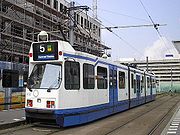
Tram line 5 (Amsterdam)
Encyclopedia

Tram
A tram is a passenger rail vehicle which runs on tracks along public urban streets and also sometimes on separate rights of way. It may also run between cities and/or towns , and/or partially grade separated even in the cities...
route in the capital of the Netherlands, Amsterdam
Amsterdam
Amsterdam is the largest city and the capital of the Netherlands. The current position of Amsterdam as capital city of the Kingdom of the Netherlands is governed by the constitution of August 24, 1815 and its successors. Amsterdam has a population of 783,364 within city limits, an urban population...
. The route runs between the centre of Amsterdam and the town of Amstelveen
Amstelveen
' is a suburban municipality in the Netherlands, in the province of North Holland. It is part of the metropolitan area of Amsterdam. The municipality of Amstelveen consists of the following villages and/or districts: Amstelveen, Bovenkerk, Westwijk, Bankras-Kostverloren, Groenelaan, Waardhuizen,...
, and is operated by the municipal transport company GVB
Gemeentelijk Vervoerbedrijf
The Gemeentelijk Vervoerbedrijf is the municipal transport company of Amsterdam. As of 2007, the GVB is an independent corporation wholly owned by the city of Amsterdam.-History:...
. The line has seventy-seven stops with an average journey time of forty minutes end-to-end.
Tramlijn 5—aside from being one of two rapid transit routes to serve Amstelveen; the other being the Amsterdam Metro
Amsterdam Metro
The Amsterdam Metro is a mixed rapid transit and light rail system in Amsterdam, and its surrounding municipalities Amstelveen, Diemen, and Ouder-Amstel in the Netherlands. The network is owned by the city of Amsterdam and operated by the Gemeentelijk Vervoerbedrijf, the company that also operates...
—also connects several important areas of the city, including the Zuidas
Zuidas
The Zuidas is a large, rapidly developing business district in the city of Amsterdam in the Netherlands. The Zuidas is also known as the 'Financial Mile'. It lies between the Amstel river and the turnaround of the ringway A10. The greatest influences for the development of the Zuidas are La...
financial district, Leidseplein
Leidseplein
The Leidseplein is a square in central Amsterdam, the Netherlands. Lying in the southwest of the Grachtengordel district of Amsterdam, the Leidseplein is immediately northeast of the Singelgracht canal. It is situated on the crossroads of the Weteringschans, the Marnixstraat, and the Leidsestraat...
and Dam Square
Dam Square
Dam Square, or simply the Dam is a town square in Amsterdam, the capital of the Netherlands. Its notable buildings and frequent events make it one of the most well-known and important locations in the city.- Location and description :...
. This makes it one of the city's busiest tram lines in service. It also has the distinction of having the most litter of any of GVB's tram lines, and also the most animals taken on board.
Infrastructure
Tramlijn 5 operates on a combination of street runningStreet running
On-street running or street running is when a railroad track or tramway track runs directly along city streets, without any separation. The rails are embedded in the road....
and segregated tram- or tram-and-bus-only highways from its northern terminus at Amsterdam Centraal railway station to just south of Amsterdam Zuid railway station. From Amsterdam Zuid, tramlijn 5 shares a segregated tramway with sneltram 51 of the Amsterdam Metro
Amsterdam Metro
The Amsterdam Metro is a mixed rapid transit and light rail system in Amsterdam, and its surrounding municipalities Amstelveen, Diemen, and Ouder-Amstel in the Netherlands. The network is owned by the city of Amsterdam and operated by the Gemeentelijk Vervoerbedrijf, the company that also operates...
to a point just before its southern terminus in Amstelveen
Amstelveen
' is a suburban municipality in the Netherlands, in the province of North Holland. It is part of the metropolitan area of Amsterdam. The municipality of Amstelveen consists of the following villages and/or districts: Amstelveen, Bovenkerk, Westwijk, Bankras-Kostverloren, Groenelaan, Waardhuizen,...
town centre.
Some platforms are located between the two tracks (cf. island platform
Island platform
An island platform is a station layout arrangement where a single platform is positioned between two tracks within a railway station, tram stop or transitway interchange...
) instead of to the side, as with the majority of Amsterdam's tram stops. Because of this, trams which provide the route's service must be equipped with doors on both sides of the vehicle; most of Amsterdam's tram vehicles have doors on the right since tram stops on other routes are located on the nearside of a road or tramway. The track layout at the line's southern terminus, Amstelveen Binnenhof, also requires tram vehicles to have a driver's cab at both ends since Binnenhof does not have a turning loop
Balloon loop
A balloon loop or turning loop allows a rail vehicle or train to reverse direction without having to shunt or even stop. Balloon loops can be useful for passenger trains and unit freight trains, such as coal trains....
so trams can turn around and face in the opposite direction.
Until 2008, tramlijn 5 trams used the elevated platforms within Amsterdam Zuid railway station proper. The construction of the Noord/Zuidlijn's terminus at Zuid meant that tram 5 had to be diverted and, today, the tram runs 200 m north of its former platforms along Strawinskylaan.
Services
Tramlijn 5's route passes through three National Tariff SystemNational Tariff System
The national tariff system is a ticketing and zoning scheme for local public transport in the Netherlands. It was designed as a nationwide scheme but is being phased out and replaced by the OV-chipkaart...
zones: ‘Amstelveen’, ‘Zuid’ and ‘Centraal’. The OV-chipkaart
OV-chipkaart
The OV-chipkaart is a contactless smart card system which is in the process of being introduced on all public transport in the Netherlands, including train, metro, tram and bus...
has been the only accepted form of payment for trams in Amsterdam since 2010; this scheme replaced the National Tariff System, though the zone of each tram stop is still publicised.

